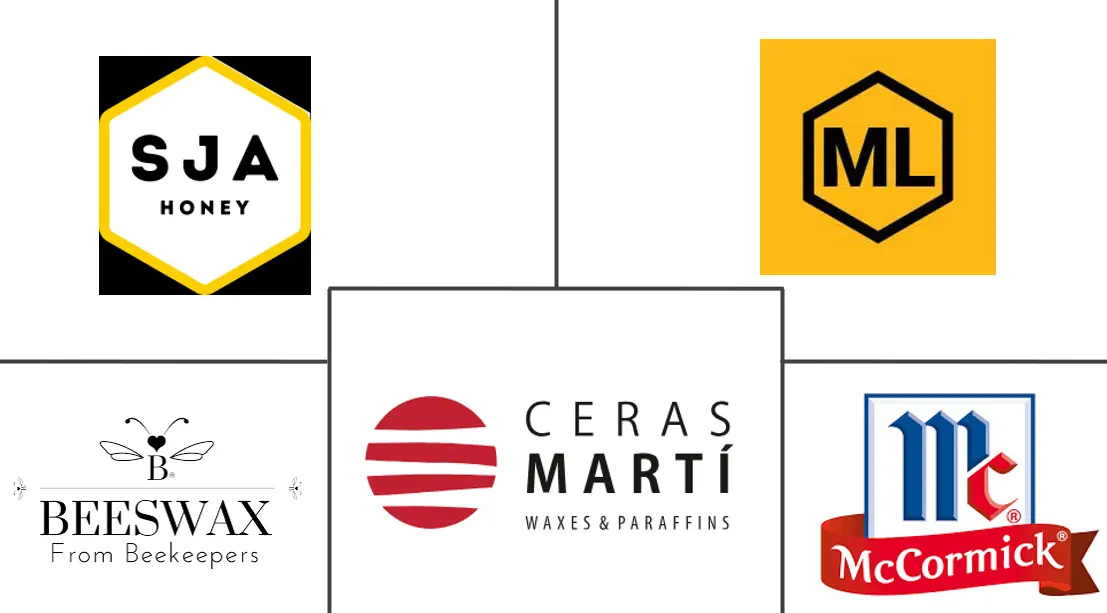Apiculture Market Size and Share
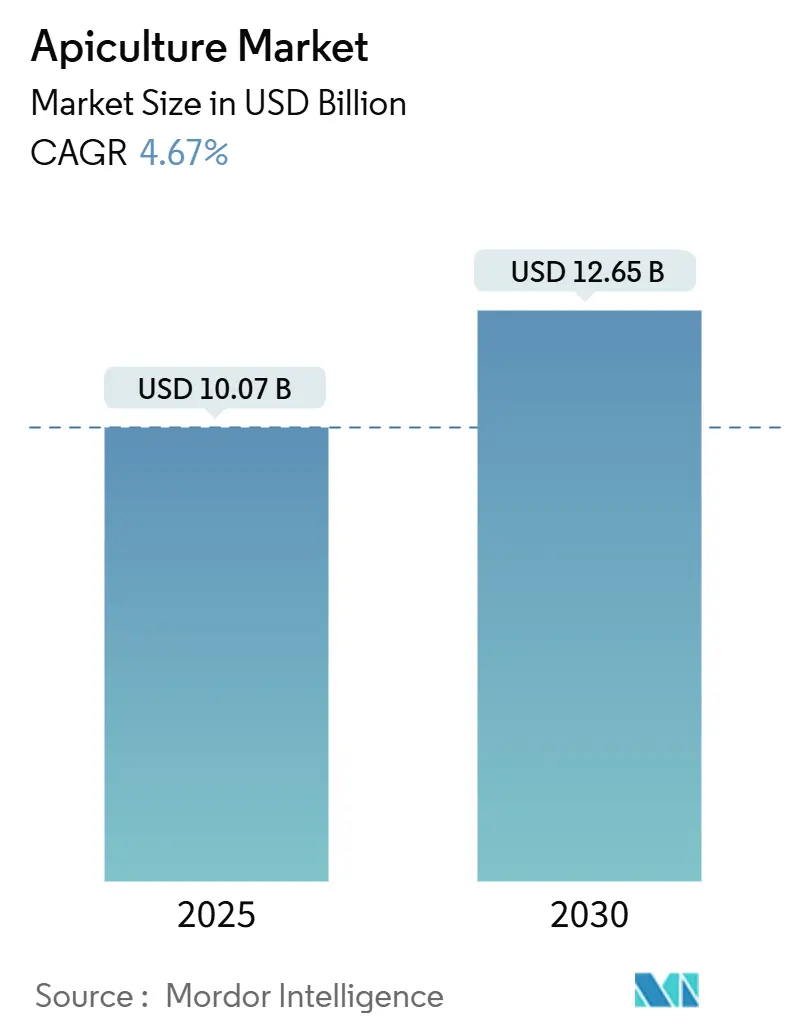
Apiculture Market Analysis by Mordor Intelligence
The apiculture market size is estimated at USD 10.07 billion in 2025. It is projected to grow to USD 12.65 billion by 2030, reflecting a CAGR of 4.67%. The apiculture market growth is driven by increasing consumer demand for natural wellness products, growing clinical validation of bee-derived ingredients, and the adoption of precision-beekeeping practices. While honey remains the primary revenue generator, bee venom and propolis have increased applications in skincare, nutraceuticals, and pharmaceuticals. The Asia-Pacific region contributes more than one-third of global production, with North America experiencing the highest growth rate due to connected-hive technology implementation. Despite pesticide-related challenges and colony health concerns, the market shows resilience through collaboration between growers, researchers, and regulators, focusing on quality, traceability, and environmental protection. The EU's new honey traceability requirements under Directive 2024/1438 and the formation of a 90-member Honey Platform to address adulteration indicate strengthening quality standards that may alter market competition [1]Source: CBI,"European Honey Market Faces Enhanced Traceability Regulations,www.cbi.eu. These regulatory changes, along with innovations such as Washington State University's pollen-replacing bee food and DNA barcoding authentication methods, are transforming the industry toward higher-value, scientifically validated products.
Key Report Takeaways
- By product type, honey held a dominant 77.22% share of the apiculture market in 2024; the live-bees segment is projected to expand at a 6.05% CAGR through 2030.
- By production method, traditional techniques dominated the apiculture market, capturing 82.43% market share in 2024, while modern methods show the highest CAGR of 6.23% over the same horizon.
- By application, food and beverage captured 73.32% revenue share in 2024; dietary supplements are forecast to record a 5.97% CAGR to 2030.
- By geography, Asia-Pacific held 34.66% share of the apiculture market in 2024; North America registers the fastest regional CAGR at 5.74% from 2025–2030.
Global Apiculture Market Trends and Insights
Driver Impact Analysis
| Driver | (~) % Impact on CAGR Forecast | Geographic Relevance | Impact Timeline |
|---|---|---|---|
| Surging global demand for natural sweeteners like honey | +1.2% | Global, with strongest impact in North America and Europe | Medium term (2-4 years) |
| Rising popularity of bee-derived wellness products | +0.9% | North America, Europe, Asia-Pacific urban centers | Long term (≥ 4 years) |
| Increasing awareness about the health benefits of honey | +0.8% | Global, particularly emerging markets | Medium term (2-4 years) |
| Booming organic and natural personal care products | +0.7% | North America, Europe, premium segments globally | Medium term (2-4 years) |
| Integration of beekeeping in agroforestry and sustainable farming methods | +0.5% | Global, with focus on developing regions | Long term (≥ 4 years) |
| Increased use of bee venom in dermatology and anti-aging products | +0.6% | North America, Europe, premium segments in Asia | Long term (≥ 4 years) |
| Source: Mordor Intelligence | |||
Surging Global Demand for Natural Sweeteners like Honey
Consumer preferences are shifting from processed sugars to honey as a natural sweetener, particularly in developed markets where health-conscious consumers drive purchasing decisions. This change aligns with the broader trend toward natural and minimally processed foods. The growing awareness of health benefits associated with honey consumption and concerns about artificial sweeteners have accelerated this transition in recent years. The Food and Agriculture Organization (FAO) reports that approximately 75% of global crops depend on pollinators, creating a symbiotic relationship between agricultural production and beekeeping activities. This relationship supports sustainable agriculture and establishes honey as a crucial element in global food security and environmental sustainability. The interdependence between crop pollination and honey production highlights the vital role of beekeeping in maintaining agricultural productivity and ecosystem balance. [2]Food and Agriculture Organization, “Good Beekeeping Practices for Sustainable Apiculture, www.fao.org
Rising Popularity of Bee-Derived Wellness Products
The therapeutic applications of bee products have evolved from traditional honey use to advanced wellness formulations for specific health conditions. Comvita's clinical trial collaboration with the University of Otago to investigate Mānuka honey's effects on digestive health demonstrates the industry's focus on evidence-based product development. The research examines how Mānuka honey influences gut microbiota composition and digestive function, aiming to validate its therapeutic benefits scientifically. Bee products in oral health applications utilize flavonoids and phenolic acids for their antioxidant and antimicrobial benefits, with ongoing research exploring their role in preventing dental caries and periodontal diseases. Royal jelly and propolis are now common ingredients in dietary supplements and functional foods, as seen in Comvita's Immune Bee™ Propolis capsules, which feature increased active ingredient concentration and sustainable packaging made from recycled materials. These products demonstrate the industry's commitment to both therapeutic efficacy and environmental responsibility.
Increasing Awareness About the Health Benefits of Honey
The health benefits of honey have driven consumer acceptance across demographic groups, particularly in emerging markets where traditional medicine aligns with modern health trends. The implementation of stingless bee honey standards in Southeast Asian and Pacific countries indicates broader recognition of honey varieties' nutritional and therapeutic properties. These standards ensure quality control and authenticity verification for different honey types, providing consumers with reliable product choices. The comprehensive studies demonstrate honey's effectiveness in various applications, from wound healing to immune system support. Research validation has strengthened consumer confidence in honey's therapeutic properties, especially in markets where traditional healing practices align with modern wellness preferences. The growing scientific understanding of honey's bioactive compounds and their mechanisms of action has further solidified its position in both conventional and alternative medicine markets.
Booming Organic and Natural Personal Care Products
Bee-derived ingredients have emerged as essential components in organic personal care formulations, driven by the growing clean beauty and sustainable sourcing trends. Beeswax maintains widespread usage in cosmetics applications globally, while European demand for certified organic honey continues to increase as consumers actively seek traceable and environmentally responsible products. The EU's comprehensive organic certification framework and strong Fairtrade honey sales in Germany illustrate consumer acceptance of premium pricing for verified sustainable products. Bee venom's documented anti-inflammatory and regenerative properties have enabled its incorporation in premium skincare formulations, particularly in anti-aging and therapeutic applications, supported by extensive research validating its cellular regeneration benefits. The European Green Deal and Farm to Fork Strategy provide robust regulatory support by establishing stringent environmental standards for honey production, creating distinct market advantages for certified organic producers.
Restraints Impact Analysis
| Restraint | (~) % Impact on CAGR Forecast | Geographic Relevance | Impact Timeline |
|---|---|---|---|
| Excessive use of pesticides and agrochemicals affecting bee health | -1.4% | Global, particularly intensive agriculture regions | Short term (≤ 2 years) |
| Labour-intensive nature of beekeeping limiting large-scale commercialization | -0.8% | Developing markets, rural areas globally | Medium term (2-4 years) |
| Dependence on weather conditions for honey yield | -0.6% | Global, with highest impact in climate-vulnerable regions | Short term (≤ 2 years) |
| Fragmented market structure results in inefficiencies in market scalability | -0.5% | Global, particularly developing markets | Long term (≥ 4 years) |
| Source: Mordor Intelligence | |||
Excessive Use of Pesticides and Agrochemicals Affecting Bee Health
Pesticide exposure poses a significant threat to apiculture growth, as colony collapse incidents correlate with intensive agricultural practices in major production regions. The BPRACTICES project in Europe, which involves numerous technical experts across multiple EU countries, demonstrates the extensive coordination needed to address bee health through standardized beekeeping practices and biosecurity protocols. The project highlights collaborative efforts between research institutions, industry stakeholders, and regulatory bodies to develop comprehensive solutions. Washington State University has developed pollen-replacing food for honey bees that meets their nutritional requirements without relying on natural pollen, marking a significant advancement in bee nutrition technology. However, beekeeping operations remain vulnerable to agricultural practices, requiring fundamental changes in farming methods to ensure the industry's sustainability. This challenge extends beyond individual farm management to encompass broader agricultural policy reforms and sustainable farming initiatives.
Dependence on Weather Conditions for Honey Yield
Climate variability directly impacts honey production through its effects on floral resource availability, colony development patterns, and seasonal productivity cycles that determine annual yield outcomes. Penn State research analyzing five decades of data revealed that honey yields in the US have declined since the 1990s, with soil productivity and eco-regional climate conditions serving as primary determinants of production success. Brazil's sugar production challenges in 2024, with São Paulo state experiencing a 6.55% decrease to 25.62 million tons due to adverse weather and disease affecting cane availability, illustrate how climate impacts extend across agricultural sectors that support bee foraging [3]Center for Advanced Studies on Applied Economics,"Amid challenges, market shows resilience, www.cepea.org.br.The development of mangrove-based apiculture in Mexico, achieving 65.37 kg per colony annually through integration with coastal ecosystem management, demonstrates adaptive strategies that leverage climate-resilient environments [4]Journal of Ethnobiology and Ethnomedicine, "Honey Production", www.ethnobiomed.biomedcentral.com. Weather dependency creates supply volatility that complicates long-term contracting and pricing strategies, requiring producers to develop diversified geographic portfolios and climate adaptation techniques to maintain consistent market supply.
Segment Analysis
By Product Type: Live Bee Sales Drive Market Evolution
Honey market maintains a dominant 77.22% share in 2024 as the primary commercial output of apiculture operations. The live bees segment is growing at 6.05% CAGR (2025-2030), indicating a shift toward service-based revenue models and colony management solutions. This growth is driven by increased demand for pollination services, as commercial agriculture recognizes the economic benefits of managed pollination beyond honey production. Beeswax production, concentrated in tropical regions with untapped economic potential, serves cosmetics and pharmaceutical applications.
Other specialized products, including bee venom, royal jelly, and propolis, generate premium pricing through their therapeutic applications. Colony health challenges create replacement demand in the live bee segment, with virus-spreading mites causing substantial losses in some regions, requiring continuous restocking of commercial operations. Washington State University's development of pollen-replacing bee food, expected to be commercially available in April 2025, may increase the demand for live bees by improving colony survival rates and reducing environmental dependencies. The growth in this segment indicates that apiculture operations are shifting toward colony management services and pollination contracts, moving beyond traditional honey production for revenue. This transformation in commercial beekeeping demonstrates how diversified services create additional revenue streams and improve market stability.
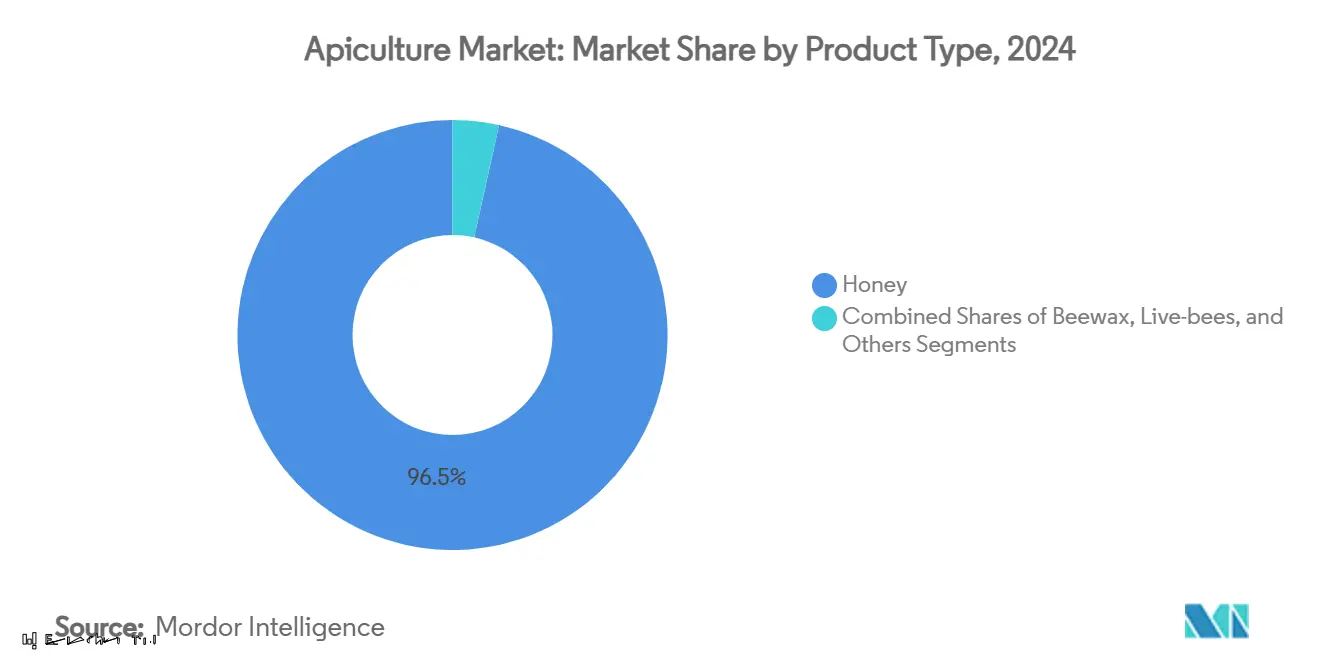
Note: Segment shares of all individual segments available upon report purchase
By Production Method: Technology Disrupts Traditional Practices
Traditional production methods maintain 82.43% market share in 2024, reflecting the industry's deep-rooted practices and the predominance of small-scale operations globally, while modern approaches accelerate at 6.23% CAGR as technological solutions address scalability and efficiency challenges. The integration of IoT sensors, automated monitoring systems, and data analytics platforms enables precision beekeeping that optimizes colony health and productivity through real-time environmental tracking and predictive maintenance. ProBee's electronic monitoring system, featuring acoustic sensors, temperature monitoring, and GPS tracking, exemplifies the technological infrastructure supporting modern beekeeping operations.
Traditional methods retain advantages in artisanal honey production and regions where labor costs favor manual processes, particularly in developing markets where beekeeping serves as a rural livelihood strategy. The FAO's emphasis on sustainable beekeeping practices that integrate traditional knowledge with modern techniques suggests a hybrid approach rather than complete technological displacement. The production method evolution indicates that competitive advantage will increasingly depend on operators' ability to integrate technological solutions while maintaining the quality characteristics that differentiate premium bee products.
By Application: Food Sector Leadership Challenged by Wellness Expansion
Food and beverage applications command a 73.32% market share in 2024, underscoring honey's fundamental position as a natural sweetener and functional ingredient. The dietary supplements segment is advancing at 5.97% CAGR, propelled by heightened consumer focus on preventive healthcare and functional nutrition. The pharmaceutical segment continues to develop through comprehensive research on bee products' therapeutic properties, with clinical studies validating their effectiveness in addressing conditions from digestive issues to skin cancer.
In the cosmetics and personal care sector, bee products serve as integral ingredients in anti-aging, moisturizing, and therapeutic skincare formulations, specifically leveraging bee venom's cellular regeneration properties. Industrial applications, despite their smaller market share, demonstrate consistent growth through systematic beeswax integration in manufacturing processes and specialized chemical applications. The implementation of advanced quality assessment methods, including the Equivalence Index for optimizing functionally opposite components, enhances industrial applications through established standardized evaluation criteria.
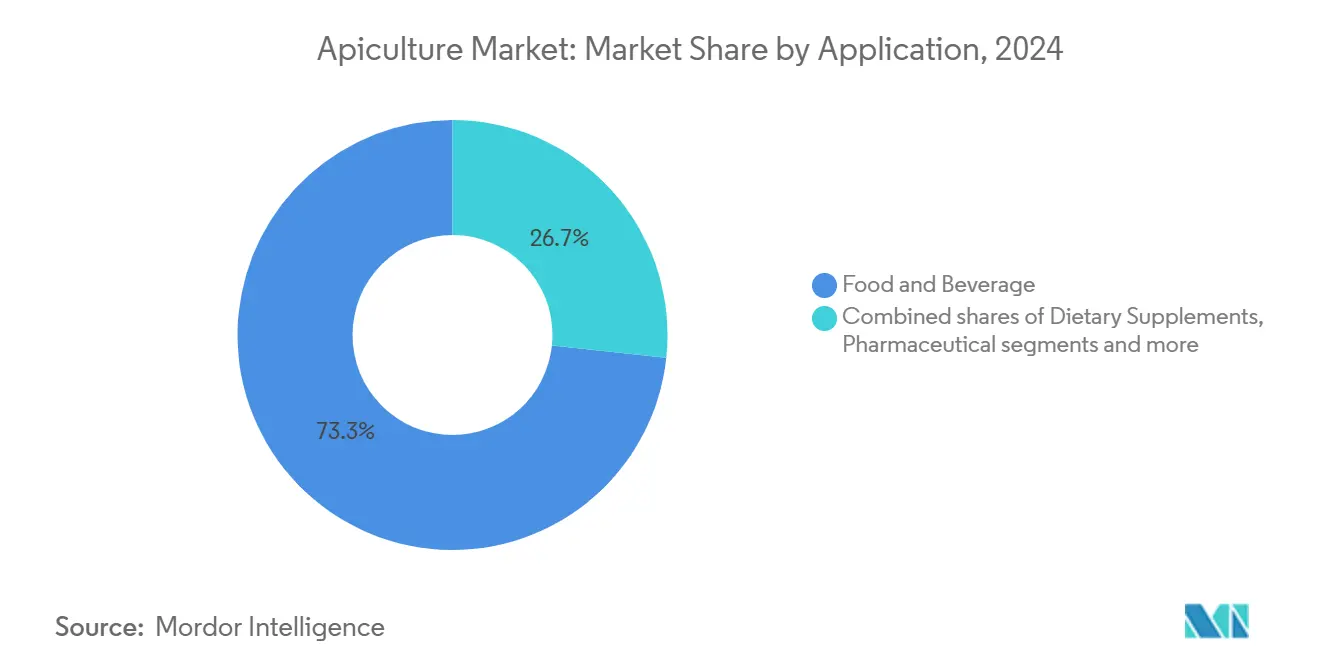
Note: Segment shares of all individual segments available upon report purchase
Geography Analysis
In 2024, Asia-Pacific commands a 34.66% market share, largely driven by China's vast production capabilities and India's growing manufacturing sector. China's dominance stems from its established infrastructure, skilled workforce, and ability to produce at scale, while India is emerging as a key player due to government initiatives like "Make in India" and increasing foreign investments in manufacturing. This region not only caters to its domestic needs but also exports a wide array of product categories, benefiting from competitive production costs and a robust supply chain network.
North America leads regional growth at 5.74% CAGR (2025-2030), driven by technological advancements, regulatory support for sustainable practices, and rising demand for premium bee products. This growth is fueled by technological advancements, regulatory backing for sustainable practices, and an increasing appetite for premium bee products. The region's market expansion is further supported by government initiatives aimed at enhancing beekeeping operations and modernizing facilities. For instance, Canada's Honey Bee Health Initiative in Ontario focuses on improving the resiliency and competitiveness of beekeeper operations, ensuring sustainable growth and innovation in the industry.
The European market maintains high quality standards, emphasizes sustainability, and implements regulations that influence global industry practices. The region's commitment to quality is evident through comprehensive testing protocols and certification requirements. In South America, the market is driven by abundant natural resources and increasing export opportunities, supported by government initiatives to enhance product quality. Meanwhile, the Middle East and Africa region is witnessing growth due to rising demand for premium products and efforts to improve regulatory frameworks to align with global standards.
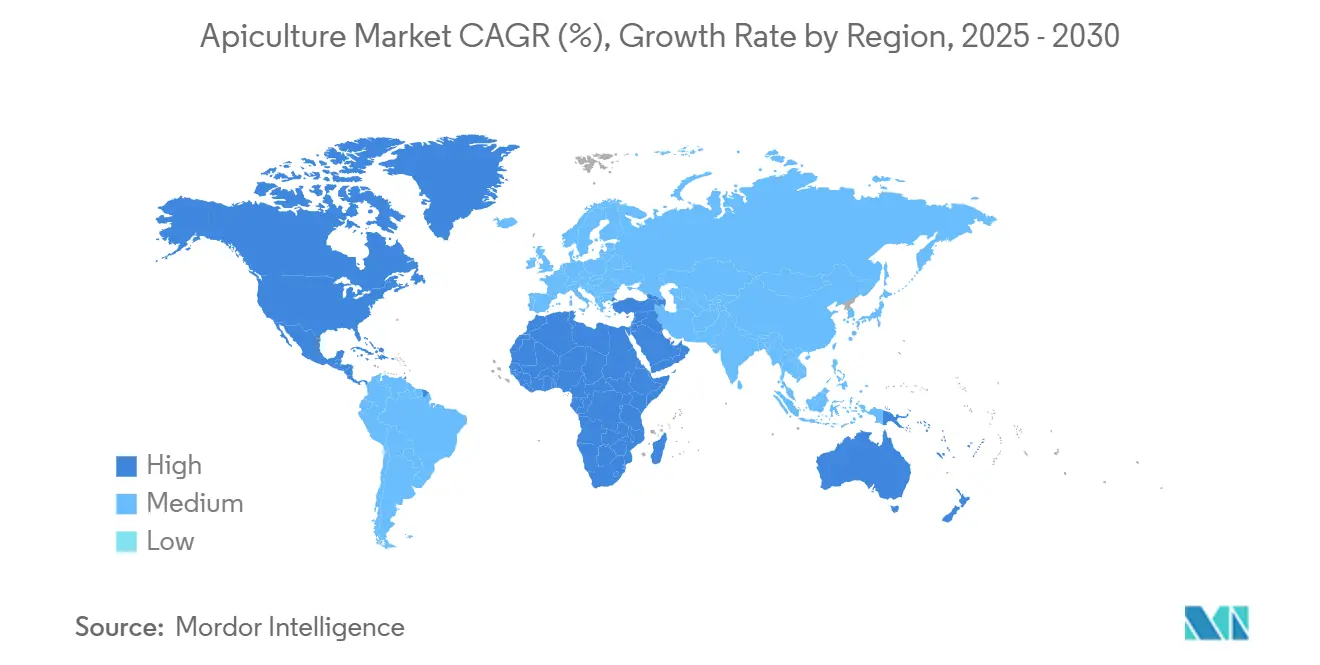
Competitive Landscape
Multiple companies operate across various product categories and geographic regions, leading to a fragmented apiculture market. Major industry players include Ceras Industriales Marti, McCormick & Company Inc., Beeswax, Mann Lake Bee & Ag, and SJA Honey. This fragmentation arises from traditional small-scale operations, regional production advantages, and a diverse range of bee products catering to different market segments.
Producers in China leverage cost-efficient operations and streamlined processes, enabling them to offer competitive pricing on the global stage. Their expansive production capabilities and optimized supply chains effectively cater to mass-market segments. In contrast, companies like Comvita and honey producers from New Zealand target premium segments, emphasizing stringent quality standards, sustainable practices, and health benefits backed by scientific validation. These firms heavily invest in research and development to substantiate their product claims and uphold their premium market stance.
Firms are setting themselves apart by embracing technologies such as IoT monitoring, automated processing, and quality authentication. These tech investments not only bolster operational efficiency but also ensure consistent product quality and stringent quality control. The industry witnesses ongoing consolidation, evident from New Water Capital's acquisition of Dutch Gold Honey and Bee-io Honey's ILS 38 million purchase of B.H. Whitestone Group in March 2025. Such mergers and acquisitions enable companies to harness economies of scale, refine operations, and broaden their distribution reach.
Apiculture Industry Leaders
-
Ceras Industriales Marti
-
McCormick & Company Inc.
-
Beeswax
-
Mann Lake Bee & Ag
-
SJA Honey
- *Disclaimer: Major Players sorted in no particular order
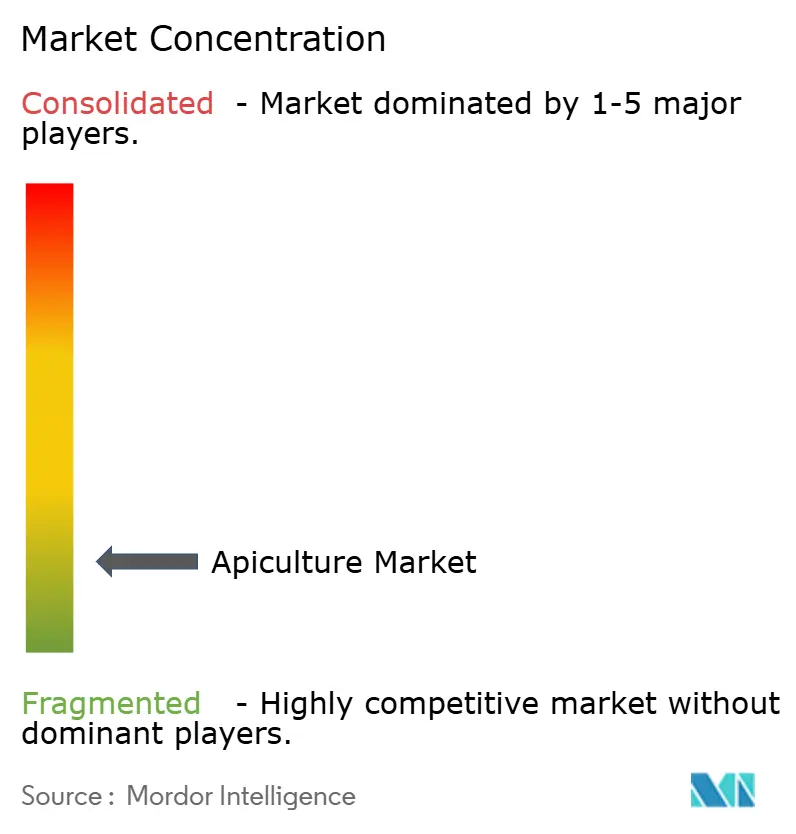
Recent Industry Developments
- June 2025: Mann Lake Bee & Ag expanded the warehouse capacity at its Kentucky facility. The expansion aims to enhance storage capabilities and improve distribution efficiency for the company's agricultural products.
- April 2025: Betterbee to expand its research, education, and honeybee health initiatives while supporting beekeepers nationwide through expert advice and quality bee colonies, adapting to challenges like colony die-offs and climate-driven hive management strategies.
- March 2025: Nature Nate's Honey Co., a major honey producer in the United States, introduced Nate's hot honey minis. The company developed these portion-controlled honey products to complement meals and snacks.
Research Methodology Framework and Report Scope
Market Definitions and Key Coverage
Our study defines the apiculture market as all revenue generated from commercial husbandry of honey-bee colonies for primary products, honey, beeswax, live bees, propolis, pollen, and royal jelly, sold in bulk or packaged form at the first point of sale. Values are captured at producer gate and later reconciled with customs and processor data across five regions.
Scope exclusion: backyard hobby beekeeping, whose output never enters organized trade, is intentionally left out.
Segmentation Overview
- By Product Type
- Honey
- Beewax
- Live-bees
- Others
- By Production Method
- Modern
- Traditional
- By Application
- Food and Beverages
- Dietary Supplements
- Pharmaceutical
- Cosmetics and Personal Care
- Industrial
- Others
- By Geography
- North America
- United States
- Canada
- Mexico
- Rest of North America
- Europe
- Germany
- United Kingdom
- Italy
- France
- Spain
- Poland
- Rest of Europe
- Asia-Pacific
- China
- India
- Japan
- Australia
- Rest of Asia-Pacific
- South America
- Brazil
- Argentina
- Rest of South America
- Middle East and Africa
- South Africa
- Saudi Arabia
- United Arab Emirates
- Rest of Middle East and Africa
- North America
Detailed Research Methodology and Data Validation
Primary Research
Mordor analysts spoke with commercial beekeepers, honey packers, veterinary suppliers, and export brokers across Asia-Pacific, Europe, the Americas, and Africa. These structured interviews validated yield assumptions, modern hive adoption rates, and price spreads, and they helped us sense-check early model outputs.
Desk Research
We began with country-level hive numbers, honey output, and export flows released by FAOSTAT, USDA, Eurostat, and China's MARA, then drew on apiculture associations such as Apimondia for yield and colony-health ratios. News archives in Dow Jones Factiva, plus company financials from D&B Hoovers, gave processor revenue and facility counts, while Volza shipment data helped benchmark export prices.
Next, we reviewed annual reports, 10-Ks, investor decks, and peer-reviewed journals on bee pathology to map cost drivers and disease impacts. This list is illustrative; many additional open and paid sources were consulted to verify figures and clarify trends.
Market-Sizing & Forecasting
We start with officially reported honey production and trade volumes, which are then converted to value through region-specific average selling prices. Results are corroborated with selective bottom-up roll-ups, such as sampled beekeeper turnover, processor capacity checks, and live-bee shipment counts, to fine-tune totals. Key variables tracked include average colony size, overwinter loss rate, share of box hives, retail honey price inflation, and regulatory shifts on antibiotic residues. A multivariate regression combined with scenario analysis projects demand to 2030; gaps in micro data are bridged using regional proxies agreed during expert calls. This is where Mordor Intelligence differentiates by continuously adjusting volumes for fresh colony-health alerts.
Data Validation & Update Cycle
We apply a two-step peer review; anomaly flags over five percent trigger re-contact with sources, and the entire model is refreshed annually, with interim tweaks when disease outbreaks, trade bans, or subsidy changes materially shift the baseline.
Why Mordor's Apiculture Baseline Earns Decision-Makers' Trust
Published estimates often diverge because research firms choose different product baskets, valuation points, and refresh speeds.
Key gap drivers include some publishers folding pollination service fees into market value, others using retail shelf prices without removing distributor margins, and several relying on single-country yield ratios for global extrapolation, whereas we update multi-country yield and price grids every year.
Benchmark comparison
| Market Size | Anonymized source | Primary gap driver |
|---|---|---|
| USD 10.07 B (2025) | Mordor Intelligence | - |
| USD 11.75 B (2024) | Global Consultancy A | Includes pollination revenue and downstream packaging values |
| USD 10.50 B (2024) | Industry Journal B | Uses fixed global yield factor and three-year-old price averages |
These contrasts show that our disciplined scoping, timely data refresh, and dual-layer validation give clients a balanced, transparent baseline they can trace back to clear variables and repeatable steps.
Key Questions Answered in the Report
How large is the apiculture market in 2025?
The apiculture market stands at USD 10.07 billion in 2025 and is set to reach USD 12.65 billion by 2030.
Which region leads apiculture production today?
Asia-Pacific leads with 34.66% of global revenue, anchored by China’s substantial honey output.
What product type is growing fastest within the apiculture market?
The live bees segment grows at a 6.05% CAGR, outpacing honey.
Why is North America the fastest-growing region?
Rapid adoption of sensor-based hive management and strong demand for premium, traceable honey drive a 5.74% regional CAGR.
Page last updated on:
